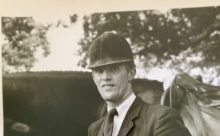Upperville Horse Show: a Brief History by Vicky Moon
The Upperville Colt & Horse Show, the oldest horse show in the country, was established as the Upperville Union Colt Club in 1853 to improve the care and breeding of work and sport horses. Richard Henry Dulany (1820-1906), an avid equestrian and fox hunter, was the founder. It’s been held on the very same grounds in Upperville, Virginia, except during the Civil War. Dulany served as a captain in the 6th Virginia Cavalry and a colonel in the 7th Virginia Cavalry. His left arm was disabled permanently in battle, and he suffered other wounds during the war.
The show also was canceled in 1917 and 1918 during World War I, between 1942 and 1945 during World War II and in 2020 due to the Covid 19 pandemic. During its 168-year history, the show has expanded to meet current needs and is considered one of the most prestigious in America. Dulany grew up on his father’s farm Welbourne near Upperville. Eight generations later, it remains in the family as a bed and breakfast and retired horse retreat and is a Virginia Historic Landmark and on the National Register of Historic Places. Dulany’s interest in improving the care and breeding of horse stock started with an annual show in 1853. The first show offered prizes for two classes – one for colts and one for fillies.
Three years later, Dulany purchased a four-year old Cleveland Bay stallion named Scrivington in England in 1856 and brought the horse to Welbourne. Scrivington had won the Royal Agricultural show in England the year before. Dulany placed a newspaper ad announcing his purchase of Scrivington and listed the horse’s stud fees. The horse show site, which remains in use today, was in an oak grove on one of his properties, known as Grafton Farm, or Number 6. A grandstand, concession stand, judges perch, two competition rings and two warm-up rings along with announcer and starter’s stands add architectural history and interest.
The Union Club reorganized after the Civil War in 1869 at a meeting hosted by Dulany. The name was changed to the Upperville Club for the Improvement of Horses, which met twice a year. A new rule codified segregation into the club. Only a white person could become a member, and each member had to pay $5 annually. Non-members could enter a colt or colts in the show, but the person had to be white. Classes were added for Thoroughbreds and in 1872 for “the best pair of colts in harness under five years old” and for “the best pair of horses to harness.”
In 1891, new rules allowed for an annual sale of horses after the exhibition concluded. Two years later, a half- or three-quarter mile track was added. The grounds became transformed as a place for families to gather and that atmosphere remains to this day. The show also expanded to three days with classes and prizes for sidesaddle, hunter classes on the flat and over hunter courses, with horses jumping out of the ring and around natural fences on the show grounds.
The 19.4698-acre horse show grounds are now owned by the Upperville Colt & Horse Show, Inc.
